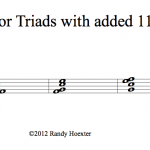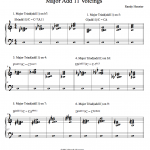In our last lesson, We discussed the use of major triads superimposed various intervals above a bass note. Adding tones to these triads can make these voicings even richer. One of many ways to enhance these triads is to add the 11th or perfect 4th to the triads. Not to be confused with sus4 chords, where the 4th replaces the 3rd, these chords keep the 3rd and add the 11th, creating a four-note shape.
Add11 Triad Shapes
There are several ways to play these triads, since they have inversions, plus the added fourth can be placed below the root position triad as well for an “open” shape. Here are all the basic configurations of this chord shape: (click for full-size)
These triads can be practiced through the same cycles that we used to learn the standard major triads, as shown in this lesson. The only difference is the addition of the 11th to each chord.
Major(add11) Superimpositions:
- On the b7: The result is b7, 9, b3, 11, creating a minor7 with added 9 and 11. Bb(add11)/C is an example. This is a very nice and rich minor voicing. I use this one a lot.
- On the 5th: This gives us 5, 7, root and 9. Major 9 voicing with added root. G(add11) /C is an example.
- On the 4th: 4, 13, b7, root. The resulting chord is a sus13. The missing 5th is not a big problem. F(add11)/C is an example.
- On the b3: Tones b3, 5, b13, b7. This could be called Minor 7 b13, “aeolian” or even a major 7 in first inversion. Eb(add11)/C is the shape. Possible chord symbols: C-7(b13) C(aeolian) or Ab∆/C. This is a difficult chord to name, but is worth using, with a nice, pensive sound. I first learned this chord from transcribing music by the late pianist Don Grolnick.
- On the 7: The tones this creates are 7, #9, 3, and #11. Without the added tone in the triad, the #9 would logically be called a b3rd, but adding the 4th to the triad creates a major 3rd and our ear then interprets b3 as #9. The chord we get from this is called major 7 #9 #11. Again, it is a difficult chord to name due to its unusual color. The implied mode is a major scale with raised 2 and 4 (lydian #9) This scale can be found by starting on the 6th degree of harmonic minor.
- On the 9: This creates an incomplete lydian chord, with 9, #11, 5 and 13. Despite the lack of 3rd and 7th, it definitely creates a major sound.
- On the 3rd: Tones 3, #5, 6 and 7. Major 7#5 with 13. Based on a lydian-augmented scale, this is a nice addition to our more “edgy” chords. the added 11 in the triad gives us the 13. Chord symbols: +∆, +∆13, Ma13(#5) etc. Example: E(add11)/C.
Here are these voicings on the staff:
(click to see full-size)
Try using these in place of your more “vanilla” voicings for a more modern and colorful sound.


Hey people!!!!!
Good mood and good luck to everyone!!!!!